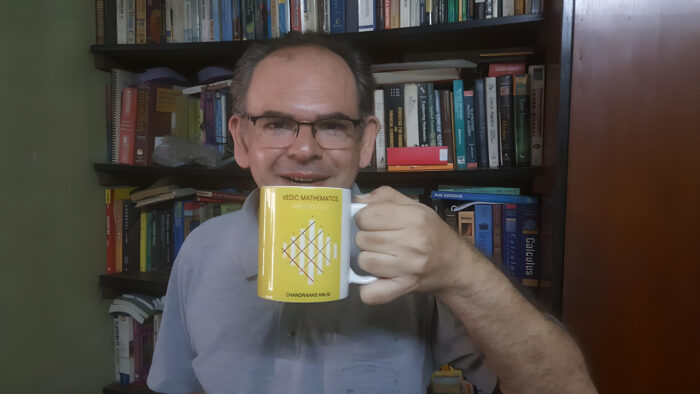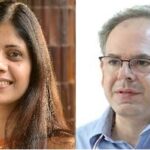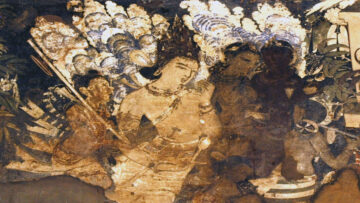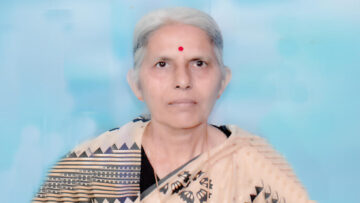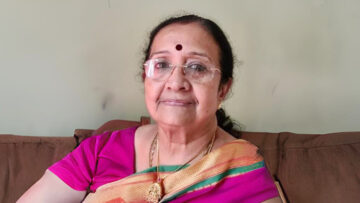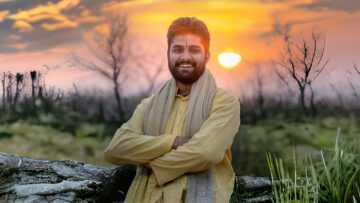“At present, we are translating articles in Indiafacts into Marathi,” Indica Today Editor in Chief Dr Yogini Deshpande told Chandrahas Halai during a chance meeting. On May 31, 2015 Chandrahas had accompanied his mentor Dr. Vasant Barve to meet his friend Prof. Deshpande (Deshpande kaka), Yogini’s father at their residence. This was his first introduction to the Indic Academy family.
The mathematician would tell her that he not only read Indiafacts regularly but would also share it with scores of friends interested in the re-emergence of our country as a leader in Math, Science and the Arts
One Saturday evening the following year, on October 15, he was invited to join the Mumbai chapter of Indic Book Club. The first meeting of Indica, Mumbai chapter was held at his place the next day evening. Since then, Indica Mumbai has organised and hosted many events – book launches, talks and presentations by scholars, researchers, and more. And Chandrahas has been an integral part of its journey.
In the year 2017, he wrote the book “Vedic Mathematics, Inside Out”, published by Crossword. Friends in Indica (especially Yogini, Dimple Kaul, Hari Kiran and Pankaj Sahay) had wholeheartedly supported and encouraged him in this endeavour. “In April 2018, Indica along with the publishers Crossword had promoted and also organised the book launch. For this, I will always be grateful to Indica,” says Chandrahas in an interview.
When Indica Today was started in 2018, with Yogini ji as Editor in Chief, he was asked to write on ancient Indian Mathematics for the publication. “The subject has always been close to my heart. Since my college days I have been collecting information and material on the same. I used to meet experts on the subject and seek their guidance. Experts like Prof. Subhash Kak, Prof. Bhalchandra Naik and Dr. Vivek Patkar have guided, blessed and supported me in this endeavour. Indica Today and Yogini provided me the platform to pursue the subject and express myself. This motivated me to further explore the subject and go deeper into it. Yogini, especially, has been a great support and inspiration.Writing for Indica Today has got me the global recognition and popularity that I enjoy today as a writer and mathematician.”
His most recent book – Meru Prastar – The Wonder World of Indian Mathematics, published in 2022 by Garuda Prakashan is dedicated to his Motherland – Maa Bharati and his mother – Late Sow. Ila Mahendra Kumar Halai, without whose blessings, he says, the book would not have been possible. In this interview he speaks about the subject closest to heart- Bharatiya Ganit or Indian Mathematics.
Often, in math textbooks used in schools, the questions or ‘word problems’ use examples that are meant to relate the mathematics to daily life. As you have mentioned in your talks, the examples used in ancient texts like the Lilavati were related to gods, spices in cooking etc. Do the types of examples used to explain mathematics have a special significance on how students understand the information? Are there any changes that should be made to the current questions?
Young students appreciate and understand mathematics when they are able to connect it with their daily activities. Youngsters have yet to develop and appreciate abstract thinking. Also there is a need to learn how to apply mathematics. In India, engineering students and engineers don’t know how to apply mathematics because they have not understood mathematics properly. The onus is on the people who design the mathematics courses and the teachers.
While speaking of ancient India’s contribution to mathematics, people either underplay its significance or exaggerate it. This leads to a lot of skepticism around the topic. How can the public’s awareness about the actual facts be made considering the huge amount of claims both ways?
In Bharat, a lot of people with half-baked knowledge or in their ignorance make hyper claims about ancient Indian science and mathematics. This does a great disservice to the very cause. This gives an excuse to left-liberals to berate or dilute our glorious scientific heritage. On the other hand, scholars in the field are seldom influential or articulate enough in highlighting or promoting our heritage. Hence, our glorious scientific heritage is not able to get its due credit.
Western scholars, scientists, mathematicians and science historians are well aware of ancient India’s significant contribution to the world of science and technology. But, very few Indian scientists are aware, or acknowledge and propagate their own scientific heritage.
I myself had learnt that the binary number system was created in India by Acharya Pingala from the book “The book of nothing” by John D. Barrow, a British physicist. There is apathy on the part of the education department to change the syllabus to make the students aware about their scientific heritage.
Calculus was invented in India much earlier than in Europe. University of Manchester has acknowledged that the invention of calculus by Leibnitz and Newton was influenced by the work of earlier Indian mathematicians. Jesuit priests who had visited India during the medieval times had carried along with them the scriptures of ancient Indian mathematicians. University of Manchester has also acknowledged the work of Prof. C K. Raju in establishing these facts. Read here.
Now, for the second part of the question: If you look at my articles, papers and books on Indian mathematicians I always quote from the primary or credible sources. Also to make my writing popular, I make it informative, interesting to read and easy to understand, so that more people read it.
How has the misinformation concerning India’s actual mathematical history and contribution affected the progress of studies in the nation? Have there been setbacks created because of ignorance of the rich well of Indian knowledge that already exists?
Misinformation about ancient Indian contribution has discouraged people to study it and the course developers to include it in the syllabus.
Fields medal winner Manjul Bhargav had said that he had got his award winning idea from Indian mathematics, which he had studied in his childhood. By not including Indian mathematics in the mainstream curriculum we have lost innumerable opportunities to create more mathematicians like Manjul Bhargav.
How did you enter the field of Indian mathematics? Were there questions that you had earlier that Western mathematics could not answer?
I come from a family of proud patriots and nationalists. As a child I used to learn about Indian history and the glory of ancient Indian science, mathematics and technology from my grandmother. This inspired me to study Indian sciences and mathematics.
As a teenager and youth I used to rummage through libraries trying to lay my hands on any information on Indian mathematics. Visit book stores and buy any book on the subject I could lay my hands on. This was before the advent of the internet.
In the journey of life, I was fortunate to come across and learn from the masters of the subject – Prof. Bhalchandra A. Naik, Prof. Subhash Kak, Prof. K. Ramasubramanian and others.
From childhood I had the habit of going into the details of things. How do things work? Trying to understand how and why they work. Who developed them? We know that ancient India gave us the place-value number system. Algebra was developed in India. Combinatorics was developed in India. Pingala gave us the Meru Prastaar (which is popularly called the Pascal’s Triangle). So, it is best to learn the subject from those who have developed it. As they say, from the horse’s mouth.
What were some major differences in the thinking process behind Western and ancient Indian mathematics?
In answer to this question, I would like to refer to my article: Mathematics, Everywhere! – Indic Today. This article conveys the significance that ancient Indians gave to Mathematics.
Till the 17th century many European mathematicians were not ready to accept the existence of negative numbers. During ancient and medieval times, Europeans associated even the numbers to geometry. You have triangular numbers, square numbers, pentagonal numbers, etc. They associated mathematics with the physical world / objects. They were not ready to transcend to abstract thinking.
On the other hand, ancient Indian mathematicians had not only developed the place value number system but also extended it to negative numbers. Ancient Indian philosophers and mathematicians were not only entertaining abstract concepts but also applying it for practical purposes.
Europeans neither had the concept of zero (void or vacuum) nor the concept of infinity (Ananta), which is required for the development of advanced mathematics like calculus.
On the other hand, in ancient India not only philosophers but mathematicians also used the concept of Shunya and Ananta. They used to be fascinated by very large and very small values (quantities or numbers). They also applied it to solve practical mathematical problems like instantaneous speeds, areas, volumes, etc.
What do you feel is the reason behind the common theorems in mathematics, which are universal, being discovered/developed earlier in India than the West?
I have mentioned earlier that till the 17th century many European mathematicians were not ready to accept the existence of negative numbers; whereas, Brahmagupta had laid down the rules for doing calculations with negative numbers in the book “Brahmasphutasiddhanta” composed in 628 CE. Refer to my article: Why is negative times negative, a positive? | chandrahas blogs
Ancient India had trade links with Egyptians, Mesopotamians, Greeks and Romans via sea and land routes for at least 5,000 years. There will have been an exchange of ideas between various civilizations. It is claimed by various European scholars like Voltaire that Pythagoras had visited India to learn its sciences. Pythagoras had turned vegetarian after visiting India. Much evidence exists for the spread of this knowledge from India to the world.
Disclaimer: The opinions expressed in this article belong to the author. Indic Today is neither responsible nor liable for the accuracy, completeness, suitability, or validity of any information in the article.

